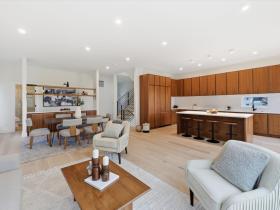 Rehabbing Your New Home with a 203k Loan
Rehabbing Your New Home with a 203k Loan
✉️ Want to forward this article? Click here.

Prospective home buyers who are interested in jumping into the real estate market by purchasing a foreclosure may be put off by the abysmal condition of some of these homes. While foreclosures are not always in bad condition, they are sold “as is”, meaning that the buyers will need to handle not only cosmetic changes (fresh paint and new carpet), but also major repairs.
If you are intent on buying a foreclosure, but are not a do-it-yourself expert then chances are you will need to hire a contractor to handle most of the work that needs to be done. Trying to figure out how to finance both a home purchase and a home rehabilitation project at the same time can leave you strapped for cash.
However, the Federal Housing Administration (FHA) has a program to help you do both: the 203(k) mortgage insurance program. These loans, which are not limited to foreclosures, can be used by homebuyers to purchase and improve any property within certain limits.
Here are a list of important restrictions to keep in mind before you take advantage of this loan:
- In the D.C. metro area, FHA 203(k) loans are limited to a maximum of $729,750, so the total value of the property cannot exceed that amount. The property’s value is determined either with an appraisal before the rehabilitation that factors in the cost of the rehab work, or 110 percent of the appraised value after the rehabilitation, whichever is less.
- The loan program is not available to investors, so the borrower must be the owner/occupant.
- The program is limited to one-to-four unit dwellings, and co-ops are not eligible. Some condos are eligible if they are in an FHA-approved development and the work is restricted to the individual unit.
- Borrowers are eligible to apply for the loan as long as they can pay the monthly mortgage payments. No specific credit scores or income levels are required.
- The minimum cost of the rehabilitation to be financed is $5,000.
- The rehabilitation work must start within 30 days of the loan agreement closing and must be completed within a time frame (not to exceed six months) agreed on in the settlement papers.
- Borrowers can do the work themselves or hire a contractor, but HUD recommends hiring an independent consultant to estimate costs to speed up the time between the loan application and the closing.
Buyers using the 203(k) loan program are also restricted against using the money for luxury improvements, so no government-funded hot tubs! Approved projects include modernizing the functions of the home, structural alterations, elimination of health hazards, reconditioning or replacing plumbing systems, roofing or floors; major landscaping or site improvement and making a home accessible for a disabled person.
For more specific information on these loans, go to the FHA website or consult an FHA-approved lender.
This article originally published at https://dc.urbanturf.com/articles/blog/rehabbing_your_new_home_with_a_203k_loan/1434.
Most Popular... This Week • Last 30 Days • Ever

With frigid weather hitting the region, these tips are important for homeowners to ke... read »

Today, UrbanTurf offers a brief explanation of what it means to lock in an interest r... read »

A new report from DC’s Office of Revenue Analysis highlights how millennials and wo... read »

The 30,000 square-foot home along the Potomac River sold at auction on Thursday night... read »

An application extending approval of Friendship Center, a 310-unit development along ... read »
DC Real Estate Guides
Short guides to navigating the DC-area real estate market
We've collected all our helpful guides for buying, selling and renting in and around Washington, DC in one place. Start browsing below!
First-Timer Primers
Intro guides for first-time home buyers
Unique Spaces
Awesome and unusual real estate from across the DC Metro













